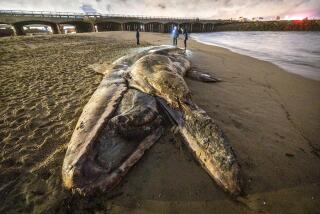Supreme Court to hear case involving Navy sonar and whales
Weighing the balance between military readiness and environmental protection, the Supreme Court said Monday that it would decide whether the U.S. Navy must limit its use of high-powered sonar off the California coast to protect whales and other marine mammals.
The justices voted to hear the Navy’s appeal of a judge’s order that requires ships to turn down their sonar whenever whales or dolphins are spotted within 2,200 yards -- 1.25 miles. A modified version of the judge’s order will remain in effect during the appeal, but the high court’s decision to hear the case is a victory for the Navy and a setback for environmentalists.
The intense sound waves from the sonar are believed to frighten, injure and possibly kill whales. But the two sides differ greatly on the extent of the effects.
Environmentalists point to studies of dead whales that washed ashore in the Bahamas, Canary Islands and Madeira islands after the Navy conducted war games nearby. Some of the animals appeared to have died of hemorrhages in and around their ears, brains and lungs. They also said the Navy’s own studies forecast that training exercises off the California coast would “significantly disturb” an estimated 170,000 marine mammals.
But the Navy said training exercises using sonar have been conducted for 40 years off California, and they “produced no evidence of sonar-related harm to any marine mammal.” Of special note, there are no reports of dead whales after these exercises, they said.
In their appeal, administration lawyers argued that the judges in California had overstepped their authority by restricting the Navy’s operations. They described “anti-submarine warfare [as] a high-stakes cat-and-mouse game” that requires days of carefully tracking sound waves. A requirement to suddenly shut down its sonar equipment “cripples the Navy’s ability to conduct realistic” training exercises, they told the court.
Last year, the Natural Resources Defense Council in Santa Monica and four other environmental groups went to court in Los Angeles seeking limits on the Navy’s use of sonar during a series of exercises planned off the California coast.
They relied heavily on the Navy’s own studies to show the probable harm to marine mammals, including the vulnerable beaked whale.
U.S. District Judge Florence-Marie Cooper agreed with the NRDC that use of the mid-frequency sonar would create a “near certainty” of harm to the mammals. In January of this year, she handed down an order that limited the Navy’s use of sonar when marine mammals came within 2,200 yards of a vessel. She said sonar could not be used with 12 miles of the coast, nor near the Catalina Basin, where whales congregate.
Navy leaders took particular exception to the requirement to power down the sonar whenever the mammals came within 1.25 miles of a ship.
“Imposing that restriction means a complete loss of training in that environment,” Vice Adm. Samuel J. Locklear, commander of the U.S. 3rd Fleet in San Diego, said Monday. “It would effectively eliminate any productive anti-submarine rehearsals.”
In February, the U.S. 9th Circuit Court of Appeals upheld Cooper’s order but modified it somewhat. During a “critical point” in a training exercise, the Navy may use the sonar at a lower decibel level even when mammals are spotted within a mile of the ship, the appeals court said.
But the administration appealed on behalf of Navy Secretary Donald C. Winter and said that even the modified order “jeopardizes the Navy’s ability to train sailors or Marines for wartime deployment during a time of hostility.”
The judge’s order appears to stand on a weak platform, the administration lawyers said.
It rests on an alleged violation of the National Environmental Policy Act, which requires the government to conduct environmental impact studies.
That law does not forbid the government from taking action, they said.
Separately, the Marine Mammal Protection Act protects whales and other marine mammals, but it includes an exception for “military readiness activity.” And in this case, the Defense Department exempted the Navy from complying with this measure during its California training exercises.
Lawyers for the NRDC said they were not surprised by the court’s willingness to hear the Navy’s appeal but said they remained confident of winning.
Richard B. Kendall, a Los Angeles lawyer who represented the NRDC, pointed out that the justices had recently rejected a similar claim from the administration that the military’s need to hold “enemy combatants” at Guantanamo Bay trumps the detainees’ right to go to court.
“We expect that the Supreme Court will again hold that the military must obey our nation’s laws, including the National Environmental Policy Act, and reinforce the message that the Navy should train using sonar, but train responsibly so that it causes the least possible harm to whales and other marine life,” Kendall said.
The high court will hear arguments in Winter vs. NRDC in the fall.
More to Read
Start your day right
Sign up for Essential California for news, features and recommendations from the L.A. Times and beyond in your inbox six days a week.
You may occasionally receive promotional content from the Los Angeles Times.







